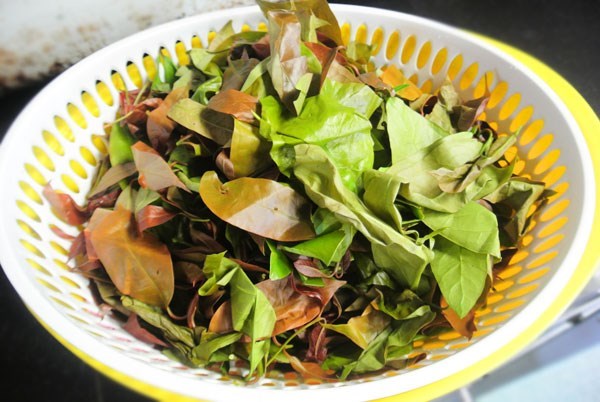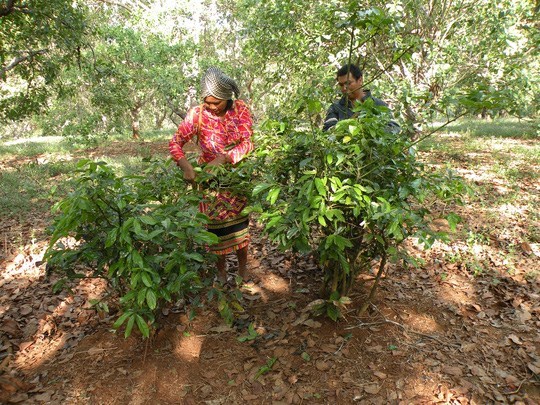It’s so amazing how Mother Nature tricksily hides a natural sweetener, which tastes similarly to MSG, in tips of amazing trees.
He
thought what we ate could poison us and the simplest example was that MSG. If
we had indulged using MSG for a long time, it might cause memory loss, taste
loss, and other harmful effects. Miserably, the habit of using artificial
seasonings has refractory stuck because we people keep thinking that those
seasonings make our food tastier.
Seeking for leaves
How do we get rid of “Chinese restaurant
syndrome” but still ensure our food’s taste? “Go learn from the mountain
people”, briefly he said.
Breaking
dawn on highlands in Da Hoai, Lam Dong province, was so pure. Fog was hanging
on trees, flowing above quite streams while birds were singing their own songs.
We Saigon-ese just walked and jumped around for 20 minutes then quickly got
tired and felt hungry.
On
the menu of the restaurant we had stopped, we focused on the name “Nhip vegetable”
(Gnetum gnemon L. var. griffithii Markgr.)
because we were introduced that it had a special taste, which was half-similar
to chicken and half-like supreme MSG. We ordered 2 dishes, stir-fried Nhip with
garlic, and stir-fried Nhip with beef.
Young
leaves were pinkish, slim, and long as young mango leaves. However, they had a
feature smell, which was not very pleasant.

Nhip vegetable, also called chicken leaves or sweetener leaves.
By
slowly chewing we tasted a transparent sweet after-taste. It’s so amazing how
Mother Nature tricksily hides a natural sweetener, which tastes similarly to
MSG, in tips of amazing trees.
This
leaf’s common name is Bep, Nhip, and other regional names, and scientifically
called Gnetum gnemon L. The book “Memories about Eastern forests” (People’s
Army publisher) told stories about how Nhip vegetables saved hundreds of
Vietnamese soldiers getting lost in Binh Phuoc forest during America – Viet Nam
war. Running out of food, they had to eat wild leaves for weeks even though they
did not know what that was. Years later, local people had found that was Nhip
leaf.
Similar
story was about Mr. Nguyen Ngoc Son, former officer from battalion 186 –
military zone 6 – and his teammates survived by Nhip leaves for days in Eastern
Highland forests. In documentary film Truong Son hung trang (The Doughty Truong Son), episode 10, Mr.
Son had told this touching story.
We
eagerly bought a big bunch of Nhip leaves back home to swank our instructor but
he just simply smiled and said that we had collected only a quarter of this
leaf and had guided us to Bom Bo village to learn more.

S’tieng people in Binh Phuoc province also smashed thick Nhip leaves then fermented them before mixing with drinks.
Lessons from Bom Bo
village
We
had gone too far to draw back. Our team packed up and gone again to the
hometown of the minorities.
We
met Mr. Dieu Khue riding his rustic motorbike, heading to cashew orchards. We
asked him taking us to find the leaves “which-taste-like-MSG” so that we could
take photos for records. “Oh, Bo-Nhau leaves”, quickly he responded. However,
he was busy that morning working in cashew orchards and only could be our tour
guide in the afternoon. Mr. Dieu immediately gave his price as 500000 vnd,
which was as much as a bowl of Kobe beef Pho.
That
S’tieng guy with russet eyes gave us plenty valued information about Bo-Nhau
leaves, such as there were 2 types, long and oval shapes, and mixing both of
them together would make great taste. Especially, they worked well with soup or
congees contained small amount of starch.
“Rice
or sweet rice, yam and other types of roots make sap of leaves taste even
sweeter”, shared Mr. Dieu Khue.
It
was a gigantic triumph just as we won a jackpot. So far, there was no
dictionary of herbs as diverse as knowledge of local people. The more we
experienced, the more empathetic we were with picturesque lyrics that told
stories of that hard time.
Our
instructor laughed so hard when seeing our second reports. He revealed huge
nourishing values of this wild leaves, “Herbal food of Nguyen dynasty honored
it as “food of God”. It It helps the liver to detoxify more effectively, also
helps kidneys and digestive system to work better. No such food has nutritional
and protein balance as Nhip leaves”, said Mr. Nguyen Phuc Ung Vien, physicians
in Go Vap district, HCMC.
Ms.
Tham, elementary school teacher in Loc Ninh town, Binh Phuoc province, added,
“Bo-nhau trees in farm land have small leaves than the one in Bu Gia Map
national forests. Leaves of trees on alkaline soil are not as sweet as the one
close to fresh water. We cook Bo-nhau leaves in soup to nourish patients and
postpartum women.”
Excitingly,
we started practicing cooking those leaves.
Ant-chicken
We
chose Hang Duong restaurant to do the very first experiment because they
usually had ant-chicken, a type of home-raised chickens from Binh Dinh or Quang
Ngai., Ant-chicken, known as one of the specialty of the Middle, were and they
slowly grew up but they have excellent meat.
At
that time, a former General, gave the restaurant owner a congee-hot-pot, which
was combined from Chinese style and the Central of Viet Nam’s style.
Chicken
was filleted, thinly sliced into 3 – 4cm long pieces then marinated with pure
fish sauce, chopped onions, and cilantro.
Chicken
bones and offal were stewed in the coogee hot pot made from grinded rice and
green been in order to sweeten the broth.
The
bunch of Nhip (Bep) leaves was water cleaned, picked, and waited to be dipped
into the congee-hot-pot.
Quite
indescribable! When the congee hot pot came to the boil, its scent irresistibly
thrived. The leaves were a bit oily and yet so sweet in an unique yet
impressive way. The more we cooked, the sweeter it was.
The
most impressive thing to mention was the after-taste. Half hour had passed but
the robust sweetness still remained somewhere on the tongues. Diners somehow
had to be addicted to this wild sweetness.
Sometimes
the writer silly wonder: why do we have bitter fruits as bitter melon, spicy
fruits as chili, and sweet leaves as those? Ph.D, physician Ngo Duc Vuong
partially explained in his book named Bright philosophy in Oriental eating as
quoted, “Plants absorb inorganic substances and synthesize to organic ones.
That is a miracle from mutual effects of natural energy that no such
ultra-modern laboratories can imitate.”
And
my instructor just briefly responded, “I have nothing else to say.”
Writer: Kien Giang/Nguoilaodong
Translator: Thu Pham